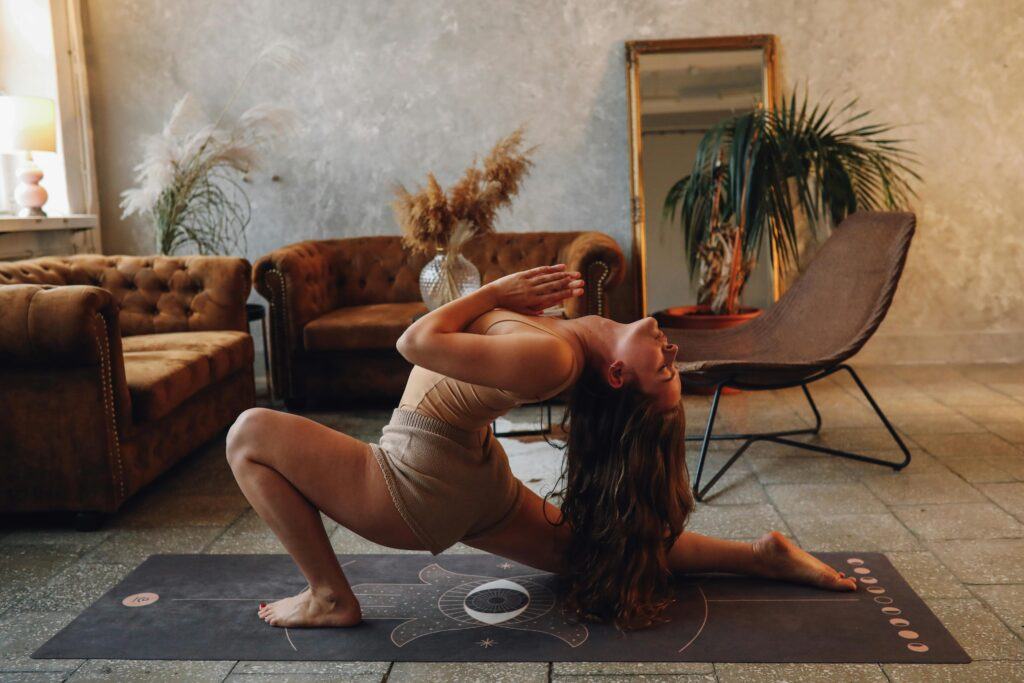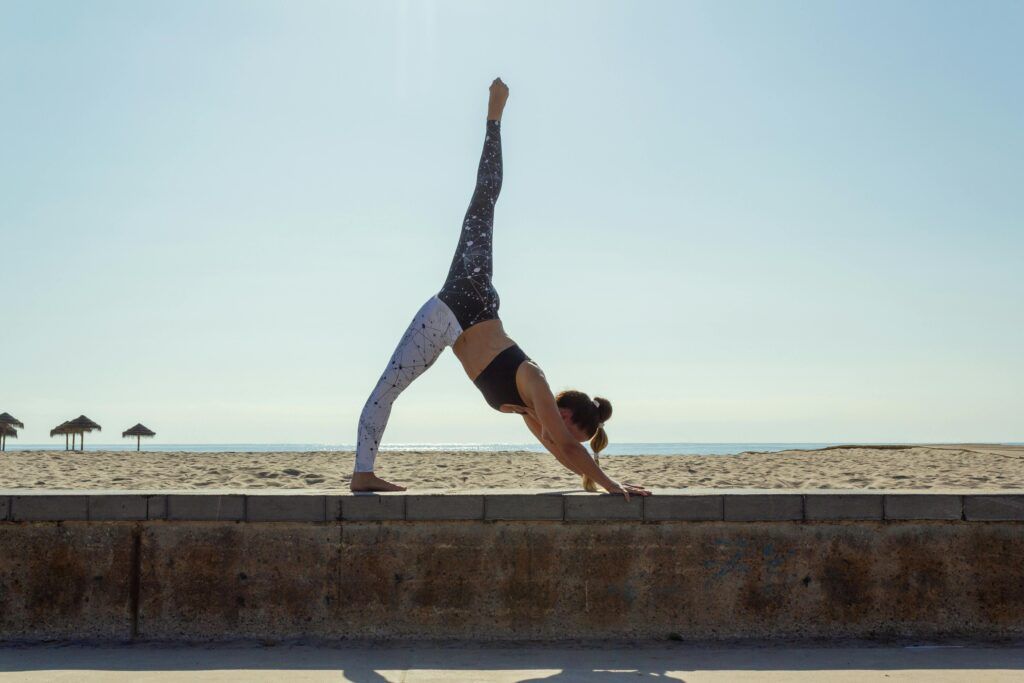Yoga, an ancient practice rooted in Indian philosophy, has evolved over thousands of years into various styles that cater to different physical, mental, and spiritual needs. Among the most popular styles in contemporary yoga practice are Vinyasa, Hatha, and Bikram.

Each of these styles offers unique benefits and approaches, making yoga accessible to individuals with varying preferences and goals. This essay explores the fundamental principles, benefits, and distinctions of Vinyasa, Hatha, and Bikram yoga, providing insights into their philosophies and practical applications.
Vinyasa Yoga
Overview and Philosophy
Vinyasa yoga, often referred to as “flow yoga,” is characterized by its dynamic, fluid movement sequences that synchronize with breath. The term “Vinyasa” originates from Sanskrit, meaning “to place in a special way,” which signifies the intentional sequencing of poses. This style of yoga has its roots in Ashtanga yoga and was popularized in the West by teachers like Pattabhi Jois. Unlike more static forms of yoga, Vinyasa emphasizes continuous movement, creating a meditative and physically engaging practice.

Practice and Key Features
A typical Vinyasa class consists of a series of asanas (poses) linked together seamlessly. The practice often begins with Sun Salutations to warm up the body, followed by standing poses, balancing poses, backbends, and finally, a cooldown sequence ending in Savasana (corpse pose). The continuous flow and breath awareness enhance flexibility, strength, and cardiovascular health.
Vinyasa classes can vary greatly in pace and intensity, ranging from slow and mindful to fast-paced and physically demanding. This flexibility allows instructors to tailor sequences to different skill levels and intentions, whether the focus is on relaxation, endurance, or strength-building.
Benefits of Vinyasa Yoga
- Cardiovascular Health: The dynamic nature of Vinyasa provides an aerobic workout that improves heart health.
- Flexibility and Strength: Regular practice enhances muscular strength and flexibility.
- Mindfulness and Focus: The emphasis on breath control and flow fosters mindfulness and mental clarity.
- Variety and Creativity: Unlike structured styles like Bikram, Vinyasa allows for creative sequencing, preventing monotony.
Hatha Yoga
Overview and Philosophy
Hatha yoga is often considered the foundation of all physical yoga practices. The term “Hatha” is derived from two Sanskrit words: “Ha” (sun) and “Tha” (moon), symbolizing balance. Unlike Vinyasa, which focuses on continuous movement, Hatha yoga emphasizes holding poses for longer durations, allowing practitioners to deepen their understanding of each posture.
Hatha yoga serves as an umbrella term for many physical yoga styles, but in modern yoga practice, it generally refers to a gentle and slower-paced approach. It is particularly suited for beginners or those seeking a meditative and restorative practice.

Practice and Key Features
A Hatha yoga session typically involves a combination of asanas, pranayama (breath control), and meditation. Poses are held for several breaths, allowing practitioners to focus on alignment and muscle engagement. Unlike the rapid transitions in Vinyasa, Hatha provides ample time for students to explore each posture in depth.
In addition to physical postures, Hatha yoga incorporates yogic philosophy, breathing techniques, and relaxation practices. This holistic approach makes it an excellent choice for individuals looking to connect the mind and body while developing strength and flexibility.
Benefits of Hatha Yoga
- Accessibility: The slower pace makes it suitable for beginners and individuals with physical limitations.
- Postural Awareness: Holding poses longer allows for proper alignment and deeper engagement.
- Stress Reduction: The focus on breathwork and mindfulness helps alleviate stress and anxiety.
- Improved Flexibility and Strength: Though gentle, Hatha still promotes muscle toning and flexibility over time.
Bikram Yoga
Overview and Philosophy
Bikram yoga, developed by Bikram Choudhury in the 1970s, is a specific form of hot yoga that follows a fixed sequence of 26 poses and two breathing exercises. It is practiced in a room heated to approximately 105°F (40°C) with 40% humidity. The intense heat is believed to facilitate detoxification, deepen flexibility, and enhance cardiovascular endurance.
Unlike Vinyasa and Hatha, Bikram follows a strict format, meaning every class is identical regardless of location or instructor. This consistency is designed to help students refine their practice and track progress over time.

Practice and Key Features
A typical Bikram class lasts 90 minutes and follows a precise sequence of standing and floor postures. The heated environment encourages sweating, which practitioners believe helps eliminate toxins from the body. The combination of heat and fixed postures challenges endurance, balance, and mental discipline.
While Bikram yoga shares similarities with traditional Hatha yoga in terms of pose selection, the heated environment and strict structure set it apart. The repetition of the same sequence ensures familiarity and incremental improvement, though some practitioners find the lack of variety restrictive.
Benefits of Bikram Yoga
- Detoxification: Sweating profusely helps flush out toxins from the body.
- Increased Flexibility: The heat allows for deeper stretches and reduces the risk of injury.
- Weight Loss and Endurance: The high-intensity nature of the practice supports weight management and cardiovascular fitness.
- Mental Strength: The challenging environment fosters mental resilience and focus.
Comparing the Three Styles
Each of these yoga styles caters to different goals and preferences:
- Intensity: Vinyasa and Bikram are more physically demanding, while Hatha offers a gentler approach.
- Flexibility and Structure: Vinyasa provides creative sequences, whereas Bikram follows a strict format.
- Environment: Bikram requires a heated room, while Vinyasa and Hatha can be practiced in various settings.
- Mindfulness and Breathwork: Hatha emphasizes meditation and breath control, while Vinyasa incorporates breath with movement, and Bikram focuses on endurance and discipline.

Conclusion
Vinyasa, Hatha, and Bikram yoga each offer distinct benefits that cater to different fitness levels and personal preferences. Vinyasa is ideal for those seeking a dynamic and creative flow, Hatha provides a foundational and meditative approach, and Bikram offers an intense, structured practice in a heated environment. Understanding these differences allows practitioners to choose a style that aligns with their goals, whether they seek physical fitness, mental clarity, or overall well-being. Ultimately, yoga’s adaptability and diversity make it a transformative practice for individuals of all backgrounds and abilities.

It’s always fascinating to see how different yoga styles cater to varying needs and personalities. I’ve personally gravitated toward Vinyasa for its dynamic flow, but I’ve been curious how does one know when it’s time to shift from one style to another? Do you think switching styles regularly can enhance one’s overall practice, or is it better to deepen your journey within a single style? Also, I’ve heard that Bikram can be controversial due to the heat and structure. What’s your take on how that environment affects both mental clarity and physical endurance over time?
Love this perspective, it really is amazing how yoga styles can match up with different energies and personalities. Vinyasa’s dynamic rhythm draws a lot of people in (myself included!), especially when you’re craving movement that feels like meditation in motion.
As for when to shift styles, I think your body and mind usually drop subtle hints. If your current practice starts to feel either too routine or not quite aligned with what you need mentally or physically, that’s often a sign to explore. Some people benefit from staying rooted in one style to go deeper, while others thrive by mixing it up and cross-training their yoga practice, so to speak.
Switching styles occasionally can definitely enhance your overall awareness, it’s like giving your body and mind new puzzles to solve. But there’s also something powerful about sticking with one path long enough to really understand its layers.
And yeah, Bikram is definitely a hot topic (pun totally intended). The heat and rigid sequence can be mentally challenging and physically demanding, which some people find transformative and others find overwhelming. Over time, it can build serious endurance and mental resilience, but it really depends on your individual tolerance and mindset. The key is tuning in and being honest with yourself about what’s truly supportive for your growth, not just what’s trendy or intense.
Appreciate you bringing up such thoughtful questions!
This was such a helpful breakdown, thank you! I’ve always been a bit confused about the differences between Vinyasa, Hatha, and Bikram, and this made it so much clearer. I’m curious to explore Hatha for a slower pace. Bikram sounds intense but kind of intriguing too! Do you have a favorite style personally, or one you’d recommend for someone looking to build consistency without feeling overwhelmed?
Thanks so much for the kind words, glad the breakdown helped! Hatha is definitely a great place to start if you’re looking for a slower pace and time to really connect with each pose. It can build a solid foundation, especially if you’re aiming for consistency without burning out.
As for favorites, it kind of depends on the mood! Vinyasa’s my go-to when I want to flow and get energized, but Hatha is perfect when I need to slow down and reset. Bikram can be intense for sure (hello, sweat!), but some people love the structure and the heat, it’s like a full mental and physical detox.
If consistency is the goal, I’d lean toward Hatha or even gentle Vinyasa. It’s all about finding what feels sustainable and enjoyable for you. Let us know what you end up trying!